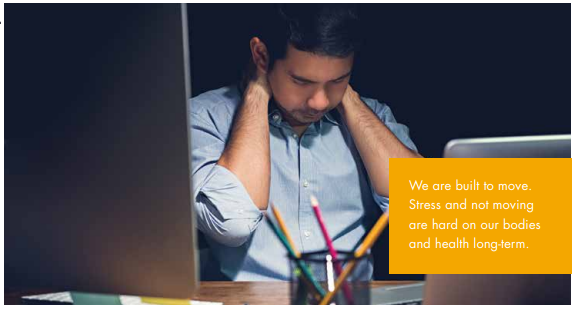
Spending too much time sitting in your office chair is dangerous, yet so many of us are pulling crazy hours at work, and our health is paying for it. Too much sitting has been linked to a higher risk of heart attack, stroke, metabolic syndrome and premature death1. Unfortunately, even the most dedicated exercise regimens won’t undo all of the damage2. At the same time, desk job related injuries are on the rise, including carpal tunnel syndrome, tennis elbow, frozen shoulders, wrist strain, neck and shoulder pain, sciatica, hip and lower back pain.
We are built to move. Stress and not moving are hard on our bodies and health long-term.
99 percent of my corporate clients struggle with pain from spending too much time at a desk and dealing with work-related stress. Luckily the solution is simple and does not require a ton of time. Simply taking the time to move will dramatically improve how your body feels.
Use these Easy-to-Implement Tips to Feel Better Fast:
- Take five minutes in the morning to stretch, breathe, and move your body. If you start your day in a stressful way, you will likely feel stressed for the rest of the day. Do just five minutes of movement in the morning to start your day with energy. Side bends, squats, downward-facing dog—whatever feels good to you. Starting your day this way will make you feel more relaxed and focused.
- Move every hour. Aim to get up and out of your seat at least once every hour. Even if you just swing your arms or take a deep breath, you will feel more alert.
Fit in stretching and strength exercises intermittently throughout your day. Stretch the front of your body (hip flexors, shoulders, lower back, hips, and chest) and engage the back of your body (upper back, core, and glutes.)
- Walk as much as possible. Hand-deliver reports or discuss an issue in person instead of via email. Researchers found that adding two minutes of light exercise to each hour of your day lowers your risk of dying prematurely by 33 percent.
- Wear comfortable shoes to work (or even walk to and from work) if you can. Keep a pair of dress shoes with you or in the office and wear them only when necessary.
- Fill your water bottle. Replenish it often. (This might result in a few extra trips to the bathroom, but that gives you even more opportunity to move!) Stand up and take the long way to the water cooler.
- Alternate your time in your desk chair by sitting on an exercise ball or using a standing desk. This will allow you to give different body parts relief from extended time in one position.
- Use the restroom on another floor and take the stairs.
- Use an activity tracker to keep count of how many steps you take. Working with a step counter or a more sophisticated activity tracker can tell you exactly how active you are during your work hours. Aim for 6,000 to 10,000 steps each day. You can even make it an office team effort by inviting your colleagues to a workweek walking challenge.
- Eat your lunch away from your desk. Walk to a restaurant or go to a nearby park. Enjoy a longer route back to the office when you are done.
- When you are too busy for a workout, find five minutes to move. Do it at the office, right when you get home, or even while waiting for the bus. Any time is better than no time when it comes to moving for energy and pain relief.
- Make working out accessible. Work out outside, in the hotel, or at home. Sometimes getting to the gym simply is not an option, but that does not have to stop you from getting some exercise.
- Have walking meetings. Invite colleagues to join you on a walking meeting or take your calls on a headset so you can move around while you talk. Researchers at Stanford University found that the creative output of people increases by an average of 60 percent when they are walking. Indoor walks were found to be just as effective for boosting creativity as outdoor walks. Get “sweat-working” and find a way to incorporate movement into your meetings.
- Set alarm reminders to move your body. A good goal is to incorporate small exercises, like stretches, every 30 to 40 minutes, and larger exercises, like walking around the office or taking the stairs, every 90 minutes. Never go two hours without moving.
Want more? Visit YouTube and stay fit at work with the Corporate Wellness Videos in this playlist
Next time your back is stiff or your mood needs a boost, pause and take a moment for a little dose of movement. A little bit goes a long way and can dramatically affect your energy, mood, and performance.
Caroline Jordan is a San Francisco–based Fitness Expert, Corporate Wellness Consultant, and Health Coach on a mission to help you develop a positive relationship to self and exercise that adds to the quality of your life. Through her services, products, events, videos, and writing, you will learn how to challenge yourself in a healthy way and explore your full potential. She can help teach you how to drop the extremes, create lasting lifestyle change, and feel good in your skin.
www.carolinejordanfitness.com
1. Sitting At Work: Why It’s Dangerous And What You Can Do, Huffington Post, 2014, retrieved from https://www.huffingtonpost.com/2012/07/24/sitting-at-work-why-its-dangerous-alternatives_n_1695618.html
2. Why not even exercise will undo the harm of sitting all day—and what you can do about it, Hanna Newman, Quartz, 2014, retrieved from https://qz.com/223160/why-not-even-exercise-will-undo-the-harm-of-sitting-all-day-and-what-you-can-do-about-it/
3. Stanford study finds walking improves creativity, May Wong, Stanford News, 2014, retrieved from https://news.stanford.edu/2014/04/24/walking-vs-sitting-042414/





